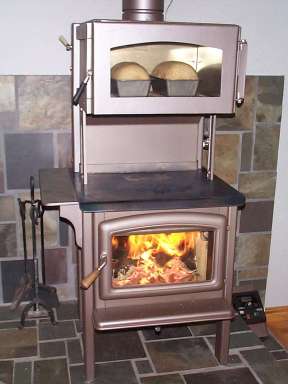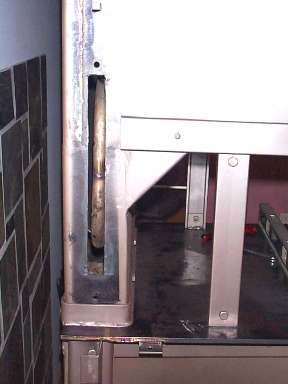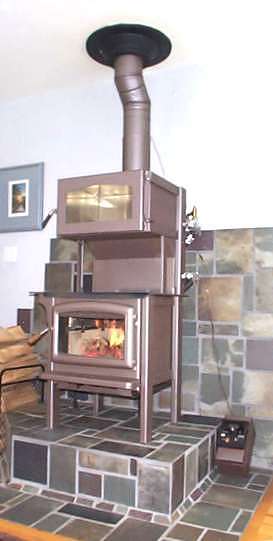I will say at the outset that I have always tried to dissuade people from building their own wood stoves, and I still think it is a bad idea in most cases. My excuse is that I have 25 years of experience in the wood burning field and am a member of all the safety standards committees so I know the risks and how to avoid them. Nevertheless, I will have trouble explaining this installation to the next home insurance inspector that calls on us.
|
Why are we investing in renewables?
The solar and electrical installation.
The wind turbine installation.
Solar domestic hot water.
A breakdown of the system cost.
System performance.
Heating the shop and battery enclosure.
The wood stove used for space and water heating and cooking.
The outdoor brickoven.
Back to the Gulland Associates Inc. home page
|
|
The idea was to start with a good EPA certified firebox and add an oven to it. I bought a Pacific Energy Super 27 with its door and ash lip. I didn't buy legs or a pedestal base because I had a design in mind and besides, the added height of the stove demanded a wide support stance both visually and for stability.
The general approach was to weld a patch into the original 6" flue outlet and rework the back of the stove to accept a full-width 20" x 4" manifold. This manifold would route the exhaust either straight up into the flue pipe or around the oven.
When the bypass damper (the handle is visible at the top left rear of the stove) is closed, the straight up path is blocked and the exhaust must flow forward through the angled part of the manifold and around the oven.
Designing and building this stove was a huge amount of work. I didn't count the hours, but it must have been several hundred. It also cost me almost $2000 just in materials and other costs. This was not a casual undertaking.
|
 |
| The oven inner liner is a 22 gauge stainless steel box with an open front. There are screws in each corner of the front flange which, when removed, allow the oven inner to pull out for cleaning of the flue passages. The flue passages are just one inch wide all around the oven. I made the passages small so the oven could be as big as possible. I was also aware that the volume of exhaust from a stove like this running normally is very small and doesn't need much flow area. It turns out that I can open the firebox loading door with the oven bypass damper closed and get no smoke roll-out as long as the chimney is hot. |

|
|
The oven bakes well. It is reasonably easy to regulate oven temperature by adjusting the stove's combustion air control. After the first winter (2001-2) I insulated the outside sides and top of the oven and the inside front of the manifold to retain some flue gas heat, which made it easier to achieve baking temperatures without overheating the house.
The stove heats the house much better than any stove we've had because of the increased heat transfer efficiency. We heat this 1500 square foot house (plus basement) with one stove, so it has to work fairly hard all winter and this has led to rather high average flue gas temperatures - in the 400 to 600°F range. The new stove averages around 150°F lower.
The increased heat transfer surface area of this stove and the very small flue passages around the oven mean that this stove would screw up badly if the user smoldered a few loads of too-wet wood in it. With careful operation, the passages stayed clean enough to go all winter without cleaning. When I took it apart I found 1/8" soft, powdery deposits.
|
 |
Domestic Hot Water
Before building this stove, we used another Pacific Energy stove with the domestic hot water (DHW) accessory option, which was a stainless steel coil in the firebox. I didn't like the effect that the cold pipe had on combustion. Because that model was the only EPA certified stove on the market with a DHW option, I started thinking about other approaches to DHW.
At right is the first DHW collector coil tried in the custom cook stove. It is made of 1/2" schedule 40 stainless steel pipe. It was installed through a slot in the exhaust manifold leading to the oven. It didn't work as well as I would have liked. It didn't make enough hot water and I didn't like it in the exhaust stream. The next photo down on the right is a view through the left side cleanout slot showing the tubular coil in place.
|

Tubular internal water coil. This heated water but not enough so it was used only one winter.

Tubular coil visible through the left side clean out slot.
|
|
At right is the second approach. I decided it would be better to get the collector out of the flue gas stream. To do that I needed a lot of surface area. The crude assembly of rigid and flexible 1/2" copper tube allowed me to try my theory without great expense.
We used this set-up during the winter of 2002-3. The grid up the back of the stove produced about 80% of the water temperature rise, which made me think I didn't need the coil on the flue pipe.
|

The second DWH collector I tried. Crude? Yes, but it taught me what I needed to know.
|
|
For the winter of 2003-4, I had a flat stainless steel tank made. It covers the whole back of the stove, from the upper rear of the firebox to the top of the oven (17" x 28"). The photo at right shows the 1" thick collector bolted to the back of the stove before it was insulated with a couple of layers of 1/2" kaowool and then a painted sheet metal cover.
This collector works well. It offers less flow restriction than previous attempts, which means the water flows faster. As a result, the temperature rise of the water is not as high as other versions, but the water in the tanks heats faster. We get adequate hot water for the two of us, although the water never gets scalding hot.
|

The flat stainless steel collector tank is visible bolted to the back of the stove. It was then insulated and covered with a painted steel shield.
|
|
Since the hot water tanks are in the basement, water must be pumped through the stove loop. The tiny 12 VDC pump is the black blob above the larger 60 gallon tank. The sidewall vented oil fired tank on the right is used for backup. Hot water to the taps is taken from the oil-fired tank. The two tanks are plumbed in series but by setting various valves heating of one or the other or both by either solar or wood power is possible.
This winter (2003-4), after several attempts to configure the plumbing correctly, the system works just fine. I have installed a standard surface mount aquastat on the back of the collector so now the pump comes on when the surface of the tank reaches 65°C.
|

Left, 60 gallon storage; right, 35 gallon oil fired.
|
|
The photo to the right shows what I hope is the final configuration of the plumbing at the stove. The small box on the floor to the right of the stove is the multi-channel thermocouple reader that gives accurate temperatures for water in and out, oven and flue gases.
Considering that this stove is a one-off experiment, it works surprisingly well. It sits right in our living room around the corner from the kitchen and is reasonably convenient to use as a cooker. Although it does have a home-made quality about it, I like to say it is not as ugly as it could have been.
I think a market could be developed for such a product if it were well-engineered, manufactured and marketed. I don't have any interest in going back into manufacturing and no manufacturers have shown any interest in the concept, so I guess North Americans will have to continue to wait patiently for someone to produce a commercially available clean cook stove.
12/03
|

Latest configuration (2003-4)
|









